|
Should Have Done My Research
I thought I was familiar with the backlist of the late Philip Kerr and had read most of his novels, with the exception of his ‘Scott Manson’ football thrillers and the reason for that omission, as I once told him, was that it would be a cold day in hell before I contributed to his Arsenal season ticket.
However, whilst recently browsing the jolly old interweb, I found a title I had not read, or actually heard of, Research, published by Quercus in 2014. That year would have seen Philip, always prolific, working on his next Bernie Gunther book (The Lady From Zagreb, published in 2015) as well as the publication of his Young Adult novel The Winter Horses and the first Scott Manson book January Window, which arrived in a blaze of publicity and which probably overshadowed this stand-alone thriller, or maybe just distracted me.

Research is a crime novel and a good one, with two or three excellent plot twists, centred on a ‘studio’ (or perhaps ‘stable’) of four writers who ghost the thrillers of the international bestseller John Houston on the plot-lines he has thought up and researched, though can’t be bothered to write. With so much money (Houston is a multi-million dollar industry) and so many egos (they’re writers for goodness’ sake) involved, there is bound to be trouble ahead and three very cold-blooded murders ensue against a background of super-rich life in Monte Carlo and France, lavish meals in luxury hotels and very expensive bottles of wine.
The problem with the book is that because it is about writers, and writers narrate the story, Philip could not resist throwing in literary references at every opportunity. Rarely a page – sometimes not even a paragraph - goes by without an author or book, or sometimes a film, being name-checked. I think Martin Amis scores highest, but others include Richard Ford, J.K. Rowling, Albert Camus, John Creasey, John Steinbeck, Jack Kerouac, Graham Greene, Erle Stanley Gardner, C.P. Snow, James Patterson (!), Oscar Wilde and Stephen Sheppard (I had to look that one up too). And just to stress the point that the writers in the story are well-read, they reference fictional characters such as Gerald Crich, Christopher Tietjens, Guy Crouchback, the Rev. Eager and Roy Batty, plus there is a High Court judge Philip cannot resist naming Cocklecarrot.
It all rather overwhelms what, when stripped back, is a damn good murder story which has echoes of the best of Patricia Highsmith and James M. Cain. (Now I’vestarted listing writers…) Or perhaps the obsessive name-dropping is the whole point. As one of the narrators wisely observes: Some sociopaths become murderers…but probably just as many become writers.
Research also contains snippets of biography when one character recalls his early career in a very conservative London advertising agency (as Philip had) in the early 1980s and another complains about having to model ‘Philip Marlowe’ raincoats in a fashion shoot for GQ magazine.
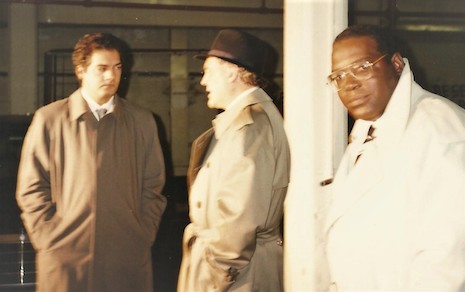
That photo-shoot did take place, in 1992, and the results appeared in the January 1993 issue of GQ in a ‘what the new generation of crime writers is wearing’ feature. The somewhat reluctant models (we were not allowed to keep the coats) were Philip, Michael Dibdin and Mike Phillips (pictured) plus Mark Timlin and myself.
Jumping the (Hammerhead) Sharks
Whilst trawling for some ‘comfort’ reading among my collection of vintage thrillers, I discover that my 1966 paperback of one of Desmond Cory’s ‘Johnny Fedora’ adventures, Shockwave, was originally published in 1963 as Hammerhead.
 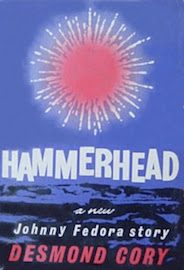
For the uninitiated or terminally young, Johnny Fedora was a freelance special agent employed mostly by the British secret service with an unofficial ‘licence to kill’ and his first appearance in the early 1950s pre-dated the arrival of James Bond. As a character he was called ‘the thinking man’s Bond’ and was also famously preferred to Bond by the distinguished critic Anthony Boucher.
Somewhere between first publication in 1963 and my paperback edition of June 1966, Hammerhead became Shockwave, which may have been something to do with the arrival on the booming spy-fi scene, of special agent Charles Hood, as created by James Mayo, in 1964 in, you guessed it, Hammerhead.
Clearly designed as a rival to James Bond (then in spectacular cinematic ascendency), Charles Hood was probably given a higher promotional budget than Johnny Fedora, who was, as it happened, coming to the end of his fictional career, and Mayo’s creation claimed the title.
 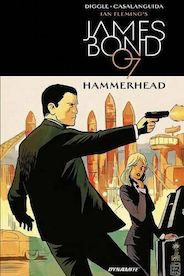
I have recently discovered that there is now a comic – or should I say ‘graphic novel’? – indeed a whole series of them, entitled James Bond 007 Hammerhead, which I suppose means you just can’t keep a catchy title down. Especially if, as one of my own deep cover agents tells me that Hammerhead was once considered as the title of a film script written by Sean Connery, Len Deighton and Kevin McClory in the 1970s in an attempt to woo Connery back into the Bond role.
The script eventually took the title Warhead and was never, say never, filmed, although Sir Sean did reprise his famous role in 1983.
I continued to gorge on comfort reading by turning to a thriller by Ronald Johnston previously unknown to me. Famous for his sea-going adventures, Red Sky in the Morning, first published in 1965, was something of a departure for Johnston as all the action takes place on Bravo Key, a tiny island off the coast of Castro’s Cuba, although it does feature a motor yacht (called Shark), a shipwreck and a hurricane.
 
The original Collins hardback jacket is considerably more interesting than the cover of my 1970 paperback edition, which looks to have been photographed at Dungeness, but this is a ripping yarn of the old school as our hero, a journalist on a fishing holiday, and his grizzled Caribbean guide and mentor, defend themselves against the bunch of anti-Castro mercenaries washed up on their otherwise uninhabited island. (The wartime back story of the Caribbean guide is a thriller in its own right and reminiscent of C.S. Forester’s Brown on Resolution, something dutifully acknowledged in the book.)
Sad News
I was saddened to hear of the death aged 83 of Jill Paton Walsh, a fine crime writer (as well as in other genres) who wrote the ‘continuation novels’ featuring Lord Wimsey.
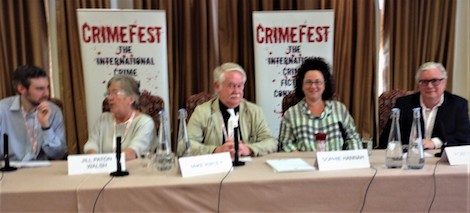
I last appeared in public with Jill on a CrimeFest panel chaired by Jake Kerridge, along with Sophie Hannah and Robert Ryan, though I have, more recently, participated in radio programmes talking about Golden Age detectives where Jill and I phoned in our contributions to the BBC from our respective homes in East Anglia, fortunately agreeing on most things.
I have a particularly fond memory of that CrimeFest panel though as, just before the panel began, I slipped off my watch and placed it in front of me so I could keep track of time. “Stop rattling your jewellery!” hissed Jill, not realising the table microphones were switched on, much to the bemusement of the audience.
A bulging post(e)bag
During the current plague, the postman barely rings once a week here at Ripster Hall to deliver books and vital supplies of Gentleman’s Relish, truffles (the ‘winter’ ones from Umbria), Black Pearl caviar from Iran and bottles of 25-year-old Irish whiskey from Ken Bruen’s private stock in his Berchtesgarden-style retreat in Galway. Occasionally a letter does get through, usually from a Mrs Trellis of North Wales but these days most people seem to communicate via something called ‘e-mail’ which I had previously assumed was the way to greet a postman in Yorkshire.
In October, the email postbag – I am told it is called an ‘Inbox’ though I always thought that was something one shouted at the cat – positively bulged, with no fewer than three publishing houses expressing their thanks for having their books mentioned. Even more satisfying, though, were the three emails from established authors who said they had been tempted to read titles (not their own) I had covered.
One American reader, a Mr Rap Sheet, opined that reading this column was “similar to eating Cracker Jack: it’s a consistently tasty treat with at least one surprise somewhere inside”.
I was, until now, unfamiliar with this popcorn-based comestible but a modicum of research informs me that historians regard it as the first junk food dating from 1896 when it was marketed with the slogan The More You Eat The More You Want. I have no idea of the taste sensations provided by Cracker Jackbut I do like the advertising strapline which, substituting the word ‘Read’ for ‘Eat’, could be the perfect mantra for Getting Away With Murder and I will have it engraved on my visiting cards immediately.
Another American, a regular reader from that famous island resort of Martha’s Vineyard (no shark jokes, I promise), wrote to exchange fond memories of books by Michael Innes and Peter Dickinson as well as the romantic novels of ‘O. Douglas’ – the pen-name of Anna Buchan, sister of the rather better-known John.
My correspondent, a discerning and very well-read enthusiast when it comes to detective stories, also recommended the work of Kathleen Moore Knight (1890-1984), of whom I was disgracefully ignorant. As the author wrote some 18 mysteries centred on ‘Pemberthy Island’, a thinly disguised Martha’s Vineyard where she lived, it seems as if I am going to need a bigger bookcase. (Sorry, couldn’t resist.)
A regular reader, correspondent and sometime informer emailed to say he was reading the ‘Max Heald’ (‘Special Agent’) books of Harry Hossent from the period 1958 to 1965, after reading about them in Kiss Kiss, Bang Bang the award-winning history of the heyday of British thrillers. All I can say is that it must have been the second edition of KK-BBas the prolific Harry Hossent (1916-1989) was missing from the first edition due to an oversight by the slipshod author.
However, my correspondent seems to bear me no ill-will and graciously concludes: With your 'Top Notch Thrillers' and KKBB, you've been responsible for influencing my novel buying for a while now, and I'm sure I'm not alone in that. So if nobody else has thanked you, I'm doing it now... thank you.
And I receive news from a distinguished and erudite editor at HarperCollins that he intends to re-issue two thrillers by Derek Lambert, written under the pen-name Richard Falkirk, in January and then June 2021.
Derek Lambert (1929-2000) was a journalist turned thriller writer, his first novel in 1959, Angels in the Snow, being based on his experiences as a foreign correspondent in Moscow for the Daily Express.
He wrote more than thirty novels, his most famous being The Yermakov Transferbut the two thrillers to be reissued, The Chill Factor and The Twisted Wire are set in Ireland and Israel rather than his favoured hunting ground of Russia. They are also described by my informant as ‘Bagleyesque’ which is a good enough recommendation for me.
Out of the West
My West Country correspondent (this column has correspondents in the eastern marches [myself], occasionally Wales, the home counties and the west, but the north is an undiscovered country) brings me the heart-warming story of Geoffrey Osborne, a loyal member of the Crime Writers’ Association’s west country chapter.
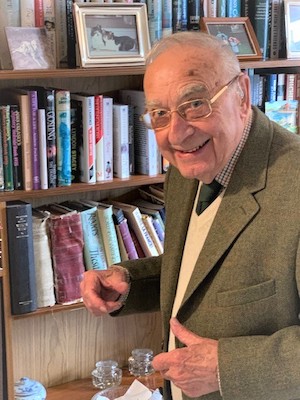

Between 1968 and 1974, Geoffrey Osborne wrote six spy thrillers which earned him a place (I’m relieved to say) in the award-winning (have I mentioned that?) Kiss Kiss, Bang Bang, although his books were described as ‘rare’: i.e. I had never read any of them.
After that initial burst of productivity, however, fans of Geoffrey Osborne, who always had the ambition to write a detective story, had to wait until this year – Geoffrey’s 90th – for his new novel, The Syndicate Six Murder to be published by Joffe Books.

By pure coincidence, the day I read of Geoffrey Osborne’s first novel since I was an undergraduate, I received the copy of John Creasey’s Mystery Bedside Book 1974 which I had purchased over the jolly old interweb. To be perfectly honest, I had bought the anthology because I saw it contained stories by Francis Clifford and Berkely Mather, two of my favourite writers covered in the award-winning etc… etc…
To my surprise and delight the anthology contained a short story, The Turning of the Screw, by none other than Geoffrey Osborne, so now I can say I have read something by him, albeit belatedly.
The Last Spiral?
One of the highlights of the regular lunches I took with the late Marcel Berlins, the distinguished crime fiction critic for the Times, was his attempt to get me to correctly pronounce the name of the hit French television show Engrenages, which is known here on BBC 4 as Spiral.

Marcel and I were both dedicated fans of this most excellent ensemble cop show set in the badlands (and law courts) of contemporary Paris, and though first created in 2006 and shown by the BBC for at least ten years, it is surprisingly little known here. In fact, I have only met one person other than Marcel, who admitted to watching it though he (a crime writer) agreed that it was superior to anything from Scandinavia or the Sicily of both the young and old Inspectors Montalbano (although the scenery is more attractive).
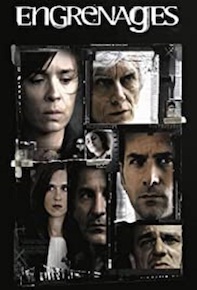
The good news for the few of us who enjoy expanding their French vocabularies with some choice Parisian obscenities, or don’t mind sub-titles, is that an eighth series of Engrenageswas completed in Paris just before lockdown, but when it becomes Spiral and is shown here is anyone’s guess. The other good news is the publication of The Lost and the Damned, a tough police procedural set in Paris, by Olivier Norek, one of scriptwriters on Engrenages. (See Books of the Month).
|
|
I Spy Two Spies
Although I have seen it listed as a novel in two places on the jolly old interweb, I do not think Kim and Jim by Michael Holzman, is.
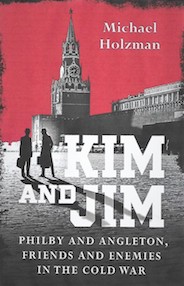
Published by Weidenfeld in January, Kim and Jim is the story of master spies Kim Philby (of MI6 and the KGB) and James Jesus Angleton (CIA) and their relationship at the height of the Cold War. Both have featured in fiction several times (viz. books by Alan Williams, Duncan Kyle, Frederick Forsyth, Robert Littell and Andrew Williams), but as American Michael Holzman has already authored biographies of Angleton, Guy Burgess and Donald Maclean, I suspect his latest work is non-fiction, yet because of the incredible circumstances of the relationship of these two spymasters, it will read like fiction.
Tweaking the Memory
As I am now of an age where remembering the right day to put the bins out can be counted as a victory, it is pleasant to discover something which brings back a clear memory of specific events of thirty years ago. Such a discovery was made whilst sorting the contents of a dusty filing cabinet here at Ripster Hall and coming across a poster which reminded me exactly where I had been on Thurday (sic) 15th November – and who I was meeting for the first time.
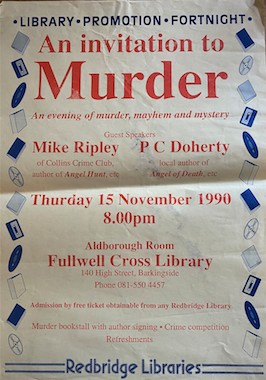
I was in Fulwell Cross Library in Barkingside, having been driven there by Maxim Jakubowski of Murder One (who I think helped organise the event), to talk crime fiction with local hero and prolific writer of history-mysteries, Paul Doherty. At the time, Paul had written six of seven novels whereas my third had just been published and I assumed that Paul’s seniority in the publishing stakes was the reason the sell-out audience treated him with such reverence, being particularly well-behaved when he was speaking, hanging on his every word.
It was only afterwards that I realised Paul was the headmaster of a distinguished local Catholic High School and our audience knew better than to heckle the headmaster. Paul and I have kept in touch over the years; he was a generous reviewer of my forays into historical fiction and his books have always given me pleasure as well as teaching me much medieval history.

I am delighted to learn that his 112th book (I told you he was prolific) will be published next month by Severn House, and even more pleased to learn that The Stone of Destiny is another title to feature Brother Athelstan, the hero of one of Paul’s most popular – and my favourite – series.
And someone who remembers exactly what he was doing fifty years ago – winning prizes with his debut crime novel – is Peter Lovesey. To commemorate half a century in the crime writing business, a special collector’s edition of that famous debut, Wobble To Death, has been produced by American publisher Soho Press.

It comes with an Afterword by the author and a Foreword by Jeffrey Deaver.
They Do Speak Latin in Hackney
Last month my eye was caught by a rather cheeky clue in the Latin crossword (number CCLX), which is the sole reason I buy The Times every Saturday.
The clue for 8 Across was Plates of meat? Ut dicunt in ’Ackneio (5). The answer, obviously, was Pedes as any Cockney would have known instantly.
The Real Inspector Hound?
The shock news that the much-lauded playwright Sir Tom Stoppard had been secretly earning squillions of Hollywood dollars “polishing” the scripts of numerous blockbusters at last answered the burning question of the origin of the line ‘Nazis – I hate those guys!’ from the third Indiana Jones movie.
Connoisseurs of film scripts and dialogue (I have a Master’s in Tarantinology) realised years ago that such a line had a distinguished provenance.
BOOKS OF THE MONTH

Angel’s Inferno [No Exit] picks up exactly where William Hjortsberg’s Falling Angel ended in 1978, when it was written, or 1959 in the context of the story. Now, forty-two years on and, spookily, three years after the death of the author, the sequel was published here on Halloween.
Readers who were seduced by Hjortsberg’s blend of hardboiled private eye story and gothic horror, as I was, never really expected a sequel as the fate of detective Harry Angel (or his ‘soulmate’ [spoiler alert] Johnny Favorite) seemed well and truly sealed by the evil – and they don’t come much more evil – genius ‘Louis Cyphre’. Angel’s Inferno sees Angel/Favorite hunting Cyphre on a suicidal revenge mission which takes places mostly in France and Italy. Our ‘hero’ goes from uncouth New Yorker, referring to France as ‘Frogistan’, to something of a bon viveur by the end of the book (which may or may not be a spoiler alert) and indeed the book could have been made sharper and punchier with a little judicious pruning of the descriptions of meals and Parisian street directions. Along the way, our protagonist absorbs a working knowledge of French, Italian and Latin. Coincidence? Perhaps not.
This is a heady mix of jazz, voodoo, black magic and sadistic violence framed as a classic private eye story with familiar tropes (hidden tape-recorders, dodgy witnesses, antagonistic policemen, stake-outs, blackmail and disguised identities) plus a substantial body count. Curiously, it works as a crime novel as well as a horror story and for conspiracy theory buffs, there’s a lengthy explanation of how St Paul was a mole in the early Christian church, planted by Satan himself. This theory is expounded in a book loaned to the protagonist by William Burroughs!

If your preference is for a more cosy take on an American private eye story set in the years post-WWII, then Stephen Spotswood has created a new detective duo who are definitely more Big Snuggle than Big Sleep. Fortune Favours The Dead [Wildfire] introduces the genteel lady detective Lilian Pentecost and her circus-trained young sidekick Willowjean Parker. Lilian Pentecost is, I suspect, ahead of her time in that she sleeps under a duvet (quite radical for 1946 New York) and is referred to throughout as ‘Ms’ rather than ‘Miss’ which may be the author’s wokeness showing through.
Otherwise the period detail seems believable but then everything I know about 1946 New York comes from Rex Stout’s The Silent Speaker, with Nero Wolfe and Archie Goodwin setting a very high bar for private eye duos.
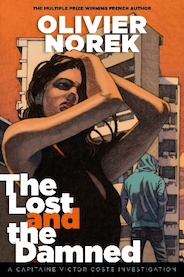
If you are a fan of the French TV series Spiral (see opposite) then you will be familiar with the landscape of the banlieues if not the actual term, which refers to the suburbs or outskirts of Paris beyond the ring road around the inner city. This is the setting for The Lost and the Damned by Olivier Norek, a former investigator with the gendarmerie in Paris and scriptwriter for Spiral. His thrillers set in the grim, tourist-unfriendly suburbs and featuring an ensemble cast of policemen and women, are bestsellers in France where this, the first in a ‘Banlieues Trilogy’ was published in 2013. Hats off, therefore, to MacLehose Press for finally bringing us the English edition.
The cops in Lost and the Damned are a fascinating, far from innocent bunch, faced with a daily litany of crime and political jockeying from other agencies. The murders (and cover-ups) they have to deal with are particularly brutal and not for the weak-of-stomach, and the book imparts lots of inside knowledge on police work in these Parisian badlands, from the most common Serbian insults to the cost of a ‘steribox’ (€1) and where to find them. This is tough, grungy and bleak crime writing of the highest order. If only the French had a word for noir…
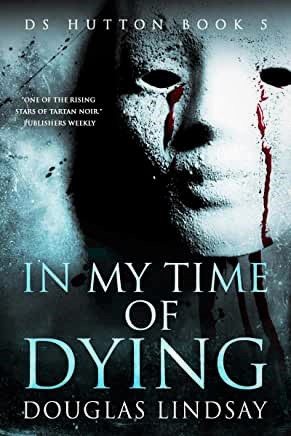
In My Time of Dying [Long Midnight] by Douglas Lindsay could be the first crime novel set in the (ongoing) coronavirus crisis. I suspect it was written in that eye of the hurricane period before the second spike and the latest restrictions imposed by the Scottish government which would surely have caused more headaches other than the ones they suffer from hangovers, for disgraced (and often disgraceful) DS Thomas Hutton and his Scottish police colleagues.
But how are social distancing and face-masks going to help catch a killer who inflicts a death by a thousand cuts on his victims? Not that that worries DS Hutton as much as where the next fix for his sex addiction is coming from.
Being Douglas Lindsay, the whole thing is done at a blistering pace with shotgun-blasts of barbs going in all directions, pitch-black humour and myriad references to popular culture and, as seems a regular occurrence nowadays, to Estonia and Lithuania. This is dark, brutal Tartan Noir in all its foul-mouthed glory. Not for readers of a delicate disposition – a bit like being stuck in a lift with Frankie Boyle.
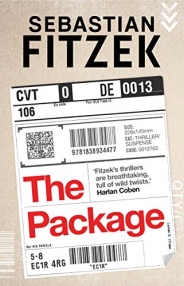
Sebastian Fitzek is a bestselling author not only in his native Germany but throughout Europe and if you enjoy psycho noir (if there is such a sub-genre) then his new thriller The Package [Head of Zeus] will not disappoint. The protagonist, Emma, after a troubled childhood then, as a young married woman, falls foul of a serial rapist killer known as The Hairdresser, who shaves the heads of his victims.
She survives, but badly traumatised and become a ‘shut-in’ in her Berlin home, alone (well, not quite) except for the intruders she imagines might be in there with her. Then a mysterious package is delivered to her door even though addressed to a neighbour who might or might not exist.
Fitzek squeezes every ounce of claustrophobic suspense out of the situation and readers begin to get the sneaking suspicion that they are either eavesdropping on a patient/psychiatrist session or have been kidnapped and held hostage in someone else’s nightmare.

The introduction of his ‘Irregular’ spy Wiggins, recruited to an infant British security service after being mentored as a youth by Sherlock Holmes, three years ago was greeted with nods of appreciation by purring fans of spy fiction. Now Wiggins returns for a third adventure, initially far from Baker Street in Queenstown in Ireland, in the year 1912, which turns out to be The Year of the Gun by H.B. Lyle [Hodder].
The year is significant as is the place, for Queenstown was the last port of call for the Titanic before its Atlantic rendezvous to restock the cocktail bars with ice, and Wiggins finds himself thrown off the ship after an ‘altercation’ over a game of cards with other passengers (third class of course). Having one lucky escape, Wiggins is soon in need of another one, or more, as he travels to Dublin – then Britain’s poorest city – and becomes involved with local gangsters running guns on behalf of the increasingly violent Nationalist movement, though a cargo of arms and ammunition would also be tempting to equally militant Unionists.
Wiggins does eventually make it to New York but his time there, and return journey, is peppered with betrayals and violence, which his mentor Sherlock would have understood, and a sexual encounter of which he would probably disapprove.
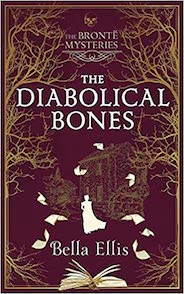
It took me a disgracefully long time to twig that the pen-name ‘Bella Ellis’ was a condensation of two other pen-names: Currer Bell and Ellis Bell, pseudonyms used by Charlotte and Emily Brontë. It is, fittingly, the pen-name of journalist and novelist Rowan Coleman for The Diabolical Bones [Hodder], her latest mystery to feature the three Brontë sisters (plus brother Branwell) as detectives tracking a vicious child killer up on the wuthering heights of nineteenth century Yorkshire.
Fortunately, in 1845, there are plenty of opportunities for the talented trio to take a break from the tedium of writing and follow their passion for amateur detection (as the Bell Brothers) on the moors above Haworth, as opposed to nearby Bradford where there are “Constables everywhere you look, spoiling the fun” – at least according to Charlotte.
I wonder what the late Robert Barnard – crime-writer and chairman of the Brontë Society – would have made of it. I suspect he would have been publicly outraged whilst privately squirming with pleasure.

A couple of years ago I was invited to have lunch with David Baldacci when he visited London but sadly, owing to a medical misfortune, I could not make it, which was a pity as I had wanted to ask him how he managed to write so many bestselling thrillers in so many different series. By my count – and I may be wrong – Baldacci has established eight contemporary and one historical series of novels, plus one in the Young Adult genre and one series of children’s books.
In Daylight [Macmillan] he chooses a hero and a heroine from two of his established series – FBI agent Atlee Pine and US Army investigator John Puller – and teams them up in an investigation into the Vincenzo family of New Jersey. When the investigation turns up leads to cold cases, one of which may connect to the disappearance of Atlee Pine’s twin sister at the age of six, it all becomes very personal.
Times A-Changing
Having mentioned a former crime fiction reviewer for The Times, I should mention the current one, Mark Sanderson, who is doing an absolutely splendid job, as is his relatively new colleague James Owen who reviews thrillers.
In his October column James Owen recommended three new thrillers – City of Ghosts by Ben Creed, City of Spies by Mara Timon and Edward Wilson’s Portrait of the Spy as a Young Man – all of which, for legal reasons, I was totally unaware.
Coming soon: ‘LOCKDOWN 2 – The Sequel’…
Keep safe, keep well, keep reading.
The Ripster.
|